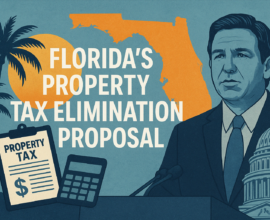Ohio Housing Market 2024 Predictions
A recent Bankrate study found that roughly 74% of Americans aspire to own a home. The national homeownership rate is approximately 66%, and the rate in Ohio is 64%, meaning that more than 3 million Ohioans remain in the market for rental housing. Based on the strong demand, real estate investors should find ample opportunities in Ohio during 2024.
A lack of affordable rental housing will continue to plague Ohio in 2024.
Here, we will forecast the outlook in 2024 for real estate investors in the Buckeye State.
Key Factors Statewide in Ohio
From a big-picture perspective, Ohio’s housing market lacks sufficient inventory, particularly for residents with lower incomes. Although inflation seems to be declining, exorbitant consumer prices still exist in many sectors. Sales in Ohio’s housing market have slowed in 2023, which largely stems from very-high interest rates and moderately high home prices.
Lower Interest Rates in 2024
The single, largest concern in today’s housing market is interest rates, with the average 30-year rate at approximately 7.61%, which represents a 20+ year high. The Federal Reserve has maintained higher interest rates since 2022 as a means of decreasing inflation.
The good news is that inflation seems to be slowly decreasing. The inflation rate was 3.7% in September 2023 and 3.2% in October 2023, which is moving in the right direction toward the goal of 2%.
The Chief Economist of the National Association of Realtors (NAR), Lawrence Yun, believes that mortgage interest rates have “peaked” and will moderately decline during 2024. Yun predicts that rates will range from 6 to 7% during the spring of 2024.
Fannie Mae also has a favorable outlook toward interest rates in 2024. Specifically, Fannie Mae estimates that 30-year fixed-rate mortgages will be approximately 7.1% early in 2024 and later fall to roughly 6.7% by the 4th quarter of 2024.
This modest drop in rates will likely mean that many prospective buyers will still find the market unaffordable.
Stable Rent Prices in Ohio in 2024
For 2024, it is safe to assume that rent prices throughout Ohio will remain largely the same — slowly yet steadily increasing. The trend should continue as prospective homeowners face affordability concerns associated with interest rates, and vacancy rates remain low. In 2022, Ohio’s rental vacancy was roughly 6%.
Large Demand for Low-Income Rental Units
A lack of affordable rental housing will continue to plague Ohio in 2024. Statewide estimates show that more than 440,000 Ohioans are deemed as extremely low-income (ELI) renters.
The Coalition on Homelessness and Housing in Ohio concurs that the supply of housing is insufficient for those with low income. Their data indicates that approximately 25% of renters were spending 50% or more of their income on housing, which leaves less than half of their income for food, transportation, and other critical expenses. They are striving to add roughly 270,000 more rental units to accommodate this demographic.
These newly constructed communities are largely composed of single-family homes that represent alternatives to apartment living.
More New Residential Housing Construction
Since 2009, new residential construction activity has slowly increased — except for during COVID. In 2022, more than 30,000 new housing units were completed across Ohio, an annual increase of more than 29% compared to 2017, which is the largest increase among its bordering states.
Data shows that approximately 71% of these newly constructed, private housing units were multifamily structures, such as condominiums or duplexes priced at market rates. Only an estimated 8% of these newly constructed units were traditional, single-family homes.
The following table outlines the new construction activity in Ohio according to region.
| Change in Residential Construction Units by Region | (2022) |
| Northeast Ohio | + 58.1 % |
| Central Ohio | + 37.7 % |
| Southwest Ohio | + 6.9 % |
| Northwest Ohio | + 2.6 % |
| Southeast Ohio | -12.4 % |
Emergence of “Build to Rent” Housing Communities
Another trend that more Ohioans will likely notice during 2024 is the presence of rental home communities or “build-to-rent” neighborhoods. These newly constructed communities are largely composed of single-family homes that represent alternatives to apartment living.
Renters are often attracted to the added privacy, off-street parking, and private yard space that these homes offer. Further, these renters have minimal maintenance responsibilities and are free of worries, including property and local school taxes.
The National Association of Home Builders reported that more than 21,000 new units were under construction during the second quarter of 2022 alone. In Central Ohio, American Homes 4 Rent is plotting its fourth such subdivision or community. Their homes typically rent for $2,500 per month.
Some of those who often find these communities appealing include:
- Millennials, such as those who lack any savings and are unable to afford a home in good neighborhoods with comparable amenities.
- Baby boomers who wish to avoid maintenance hassles and are seeking single-story, ranch-style homes without stairs.
- Investors who find that their operating costs are lower and that their tenant retention rates are higher. Also, investors often retain the option of selling the home to a single-family homebuyer in the future.
While Ohio might not be the “hottest” market for eager investors, it remains viable overall.
Declining Populations in Ohio Housing Markets?
A recent Yahoo! Finance report reminds us of the importance of properly interpreting population data. For example, the Cleveland, Ohio, real estate market was cited as one that poses significant challenges, even for savvy investors. The post explained that Cleveland was struggling with a decreasing population, persistent poverty, and vacant or abandoned properties.
First, it is critical to understand that many of these negative assessments are based on data pertaining exclusively to the City of Cleveland, which represents only a fraction of the overall, regional house market. In many cases, the data is presented in a way that implies the residents leaving the inner-city are moving to another metro area or state, yet many of these individuals simply moved to local suburbs in the same general housing market.
Secondly, this same source also referred to the Cleveland market as “undergoing a renaissance” with active “revitalization efforts.” The Wall Street Journal and Realtor.com collaborated on a report of “emerging” markets that found Ohio’s Rust Belt, and the overall midwestern area of the U.S. were poised for improvement because of the tremendous affordability and how demand exceeds the supply of homes.
Here, the bottom line is that some of the negative reporting regarding the Ohio real estate market is exaggerated and often contradicted.
Substantial Investor Activity Continues in Ohio
Recent data shows that investors bought 16% of the homes sold in Cleveland and 15% of those sold in Cincinnati during 2021. While Ohio might not be the “hottest” market for eager investors, it remains viable overall.
Keep in mind that investors who can make cash offers are in the best position currently in competitive environments, which is particularly true with today’s steep mortgage interest rates.








